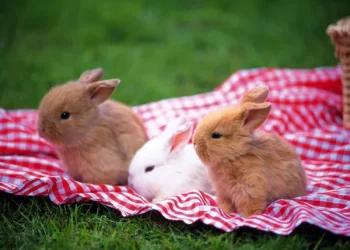Rabbits, those endearing and inquisitive creatures, make for captivating pets, bringing a touch of the wild into our homes. They are not only cherished for their fluffy coats and gentle demeanor but also for their complex behaviors and needs. One critical aspect of their well-being is exercise, a vital component in maintaining their health and happiness. This article delves into the exercise requirements of rabbits, exploring their breed characteristics, natural habits, and the specific exercise needs they have to lead a fulfilling life.
Understanding Rabbit Breeds and Their Characteristics
Before diving into exercise specifics, it’s essential to understand the diverse world of rabbit breeds and their characteristics. Rabbits come in a variety of shapes, sizes, and temperaments, and these variations can influence their exercise needs.
Breed Diversity and Size
Rabbits are classified into several breeds, each with unique traits. Broadly, they can be categorized into three size groups: small, medium, and large. Small breeds like the Netherland Dwarf or the Mini Rex are compact and may have different exercise needs compared to their larger counterparts, such as the Flemish Giant or the English Lop. Generally, larger breeds may require more space to exercise due to their size, while smaller breeds can be content with more confined areas.
Temperament and Activity Levels
In addition to size, rabbit breeds differ in their temperament and activity levels. For example, some breeds like the Holland Lop are known for their playful and curious nature, while others like the English Angora might be more laid-back. Understanding a rabbit’s breed-specific temperament can help tailor their exercise routine to their natural inclinations.
Health Considerations
Each breed has its unique health considerations which can affect their exercise needs. For instance, larger breeds are more prone to obesity and may need more structured exercise routines to maintain a healthy weight. On the other hand, smaller breeds may be more susceptible to injuries if they overexert themselves. Tailoring exercise routines to these breed-specific needs is crucial for their overall well-being.
Natural Habitat and Behavior
To appreciate the exercise needs of rabbits, it’s helpful to consider their natural habitat and behavior. In the wild, rabbits are highly active animals with specific behaviors tied to their survival.
Wild Rabbit Habits
Wild rabbits are known for their burrowing and foraging behaviors. They spend a significant amount of time running and hopping in search of food, establishing territories, and escaping predators. This constant movement is essential for their physical health and mental stimulation. Their natural instincts include digging, jumping, and exploring, which are all forms of exercise.
Social Structure
In the wild, rabbits live in complex social structures, often in large burrow systems. This social behavior means they are used to constant interaction with other rabbits, which also contributes to their physical activity. Domestic rabbits, though often kept alone, still retain these social instincts, and their exercise routines should ideally incorporate social interaction.
Adapting to Domestic Life
While domestic rabbits may not have to worry about predators or foraging for food, they still need to mimic their natural behaviors to stay healthy. This includes providing opportunities for them to dig, jump, and explore within the confines of a home environment.
Exercise Needs of Domestic Rabbits
Understanding the natural behaviors and needs of rabbits helps us tailor appropriate exercise routines for our pets. Domestic rabbits, though sheltered from many of the hazards of wild life, still require specific types of physical activity to maintain their health.
Importance of Space
One of the most crucial aspects of providing exercise for domestic rabbits is ensuring they have ample space. Rabbits require a significant amount of room to move around freely. A cramped environment can lead to physical and psychological issues such as obesity and depression.
Exercise Requirements by Age and Health
The exercise needs of rabbits can vary based on their age and health status. Young, healthy rabbits typically have higher energy levels and require more exercise compared to older or less active rabbits. For senior rabbits or those with health issues, exercise should be adjusted to accommodate their physical limitations, focusing on gentle activities.
Types of Exercise
Rabbits benefit from a variety of exercises that cater to their natural behaviors:
Hopping and Running: Rabbits are natural hoppers and need space to exercise their legs. Providing a safe, enclosed area where they can hop and run freely is essential.
Digging and Chewing: Digging is a natural behavior for rabbits. Providing a designated digging area or offering safe toys that allow them to dig can satisfy this instinctual need.
Interactive Play: Toys and interactive play sessions help stimulate a rabbit’s mind and body. Items like tunnels, climbing structures, and toys that encourage problem-solving can keep them engaged.
Social Interaction
Social interaction is another vital aspect of a rabbit’s exercise routine. Rabbits are social animals and often benefit from the company of other rabbits or interactive playtime with their human companions. Socializing with other rabbits or engaging in playful activities with their owners can help meet their exercise needs while also satisfying their social instincts.
Creating an Ideal Exercise Environment
To ensure that rabbits get the exercise they need, it is important to create an environment that supports their physical activity. Here are some guidelines for setting up an ideal exercise space:
Safe and Enclosed Areas
Create a safe, enclosed area where your rabbit can exercise freely. This could be a large playpen or a rabbit-proofed room. Ensure the space is free of hazards such as electrical cords or small objects that could be ingested.
See Also: What Do Rabbits Need for Beginners?
Enrichment and Toys
Incorporate a variety of enrichment toys and structures in their exercise area. Items such as tunnels, ramps, and chew toys can provide mental stimulation and physical exercise. Rotate toys regularly to keep their environment interesting.
Outdoor Playtime
If safe and feasible, consider allowing your rabbit supervised outdoor playtime. An enclosed yard or a secure rabbit run can provide a change of scenery and additional space for exercise. Always supervise your rabbit during outdoor play to protect them from potential predators or accidents.
Exercise Routine
Establish a regular exercise routine to ensure your rabbit gets sufficient activity. Consistent playtime and opportunities for exercise should be part of their daily routine. Observe your rabbit’s behavior and adjust the exercise routine as needed based on their energy levels and health.
Monitoring Health and Adjusting Exercise
Regular monitoring of your rabbit’s health and exercise routine is essential to ensure they remain in optimal condition. Pay attention to signs of obesity, lethargy, or any physical discomfort, and adjust their exercise routine accordingly.
Signs of Adequate Exercise
Healthy, active rabbits should display normal behavior, including exploring their environment, interacting with toys, and engaging in playful activities. Regular hopping and running without signs of distress indicate that your rabbit is getting adequate exercise.
Addressing Exercise Deficiencies
If a rabbit is showing signs of weight gain, lethargy, or behavioral issues, it may be necessary to reassess their exercise routine. Consult with a veterinarian to determine if any underlying health issues might be affecting their ability to exercise and make adjustments as needed.
Veterinary Consultation
Regular check-ups with a veterinarian can help monitor your rabbit’s overall health and ensure that their exercise needs are being met. A vet can provide tailored advice based on your rabbit’s specific health needs and any breed-related concerns.
Conclusion
Rabbits, with their varied breeds, temperaments, and natural behaviors, require a well-thought-out exercise routine to maintain their health and happiness. By understanding their natural instincts and creating a stimulating environment, you can ensure that your rabbit gets the physical activity they need. Regular exercise, coupled with appropriate space and interactive play, will help your rabbit lead a fulfilling and active life, enhancing their overall well-being and strengthening the bond between you and your furry companion.
Related Topics:
























